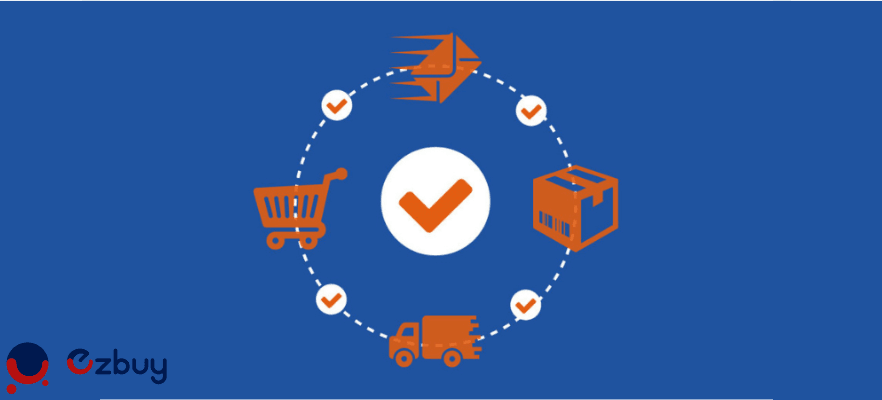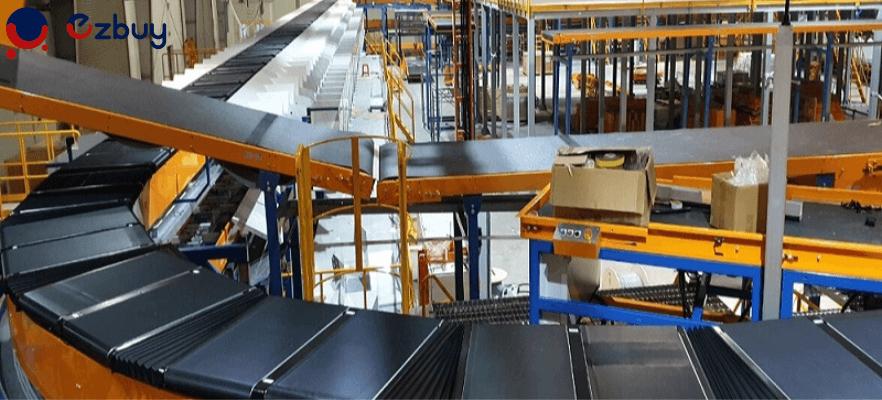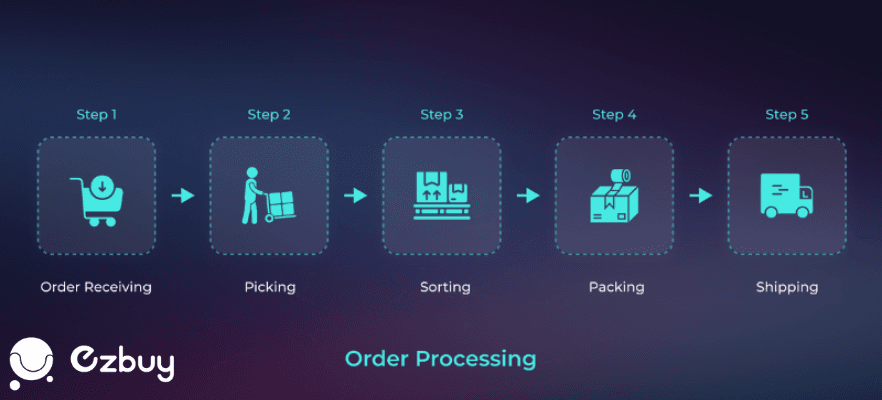Ecommerce Order Processing: Your Guide to Streamlined Operations in 2025
By Macy -17/03/2025 UTC.
The world of e-commerce is evolving at an unprecedented pace. To stay competitive, businesses need to optimize every aspect of their operations, and order processing is no exception. This guide will delve into the importance of ecommerce order processing and best practices to help you streamline your operations.
1. What Is Ecommerce Order Processing?
Ecommerce order processing encompasses the steps from order receipt to product delivery, including picking, packing, and shipping. The primary objective is to ensure accurate and timely order fulfillment, providing a seamless customer experience and improving operational efficiency.
Ecommerce businesses have three primary approaches to ecommerce order processing: in-house, dropshipping, and 3PL. The best method depends on factors like resources, business needs, and goals.
In-house warehousing offers complete control but requires significant investment. Third-party logistics (3PL) providers offer expertise and scalability, reducing management burden. Dropshipping minimizes inventory needs but relies on reliable suppliers.

2. The Ecommerce Order Processing Workflow: Step-by-Step
The ecommerce order processing workflow involves several key stages, each crucial for ensuring timely and accurate delivery. Here's an overview of the ecommerce order processing steps:
2.1. Order Placement
After a customer places an order on an ecommerce platform, the fulfillment journey begins. The first step is for the business to collect and accurately record all relevant order information, including the customer's details, payment method, and shipping information into the order system.
Companies with multiple fulfillment centers can utilize their order processing system to optimize delivery. The system selects the best center based on proximity to the customer and item availability.
For smooth order fulfillment, businesses require an integrated order processing system to accurately record customer information and order specifics. Any inaccuracies during this phase can lead to mistakes in shipments, which can delay deliveries and increase fulfillment costs. The data generated also plays a crucial role in improving demand forecasting, managing inventory, and better resource allocation, which optimizes warehouse operations.

2.2. Picking
The picking process involves identifying and retrieving the ordered products from their respective locations. Using a warehouse management system, staff members gather the items listed on the picklist. The speed and accuracy of picking directly affect how fast orders can be fulfilled. Here are some of the common picking strategies in e commerce order process:
- Piece Picking: This strategy involves staff selecting items for one order at a time. This technique is commonly used in smaller-scale businesses or for orders that involve a large variety of individual items.
- Batch Picking: Staff gather items for more than one order at once, reducing the number of trips required and enhancing overall efficiency in the warehouse.
- Zone Picking: In zone picking, the warehouse is divided into zones. Pickers are assigned to specific zones and collect items only from their designated area. Orders requiring items from multiple zones involve inter-zone transfers.
- Wave Picking: Wave picking combines elements of zone and batch picking. It optimizes fulfillment by organizing orders into waves based on factors like delivery times and priorities.

2.3. Sorting
The sorting step organizes picked items by order number or delivery point. Various sorting techniques are used, particularly for complex orders or when processing multiple orders concurrently:
- Order-based Sorting: Each order is considered individually, and the items within it are arranged accordingly. This approach is best suited for handling intricate orders with numerous items.
- Product-based Sorting: Items that are alike are bundled together, regardless of their respective orders. This method is often implemented in batch picking and is particularly efficient for warehouses dealing with a large number of similar items.
- Location-based Sorting: This process categorizes items based on where they are to be shipped, making it particularly advantageous for logistics that cover multiple geographic destinations.
- Carrier-based Sorting: In this system, items are organized based on the shipping carrier or transportation method used. This is advantageous for businesses that employ different carriers, ensuring that items meet the individual guidelines of each one.

2.4. Packing
After sorting, warehouse staff carefully pack the products for shipment. This stage focuses on selecting suitable packaging that protects items during transit while considering cost and environmental impact.
The shipping boxes need to be weighed and have the customer's address and any delivery instructions clearly marked. Proper packing is critical to prevent damage during shipping. It also represents the brand because creative, branded packaging can enhance the customer experience.

2.5. Shipping
Shipping is the final step of order processing. Here, the packed orders are delivered to the customers. This involves selecting a courier or shipping service based on cost, delivery speed, and destination. Depending on their business model, businesses can either ship directly to the customer or consolidate orders based on destination to minimize the total number of shipments based on locale.
As the order is being shipped, it's crucial to continuously update the order status and share tracking information with the customer. Ensuring fast and reliable shipping is vital for customer satisfaction. Statista’s 2023 findings reveal that 47% of U.S. consumers abandoned their online carts during checkout because of added charges, including taxes and fees.

>>> Read more: How can 3PL e-commerce fulfillment empower your business in Japan?
3. Factors Affecting Ecommerce Order Processing
Choosing the right e-commerce order processing approach requires evaluating various factors, including product characteristics, order sizes, packaging needs, productivity objectives, and seasonal trends. Rule-based order processing allows companies to create flexible workflows tailored to their needs:
- Product Characteristics: Large or delicate items need special care in packaging and handling, while perishable items, such as food, require quicker processing and specific storage conditions, which can impact the order processing in ecommerce. High-value goods may also require added security measures during their processing and delivery.
- Order Sizes: Large-scale operations can maximize efficiency with automated systems and batch picking strategies, while smaller businesses can achieve cost savings by utilizing manual sorting and piece picking methods.
- Packaging Needs: Companies must decide whether to go with standard packaging or customized branded options, depending on their business model and brand image. For those dedicated to sustainability and minimizing waste, it’s important that the packaging materials reflect an environmentally conscious approach.
- Productivity Objectives: Strategies for order processing should be designed to increase efficiency, minimize processing time, and optimize labor utilization in line with business objectives. Training for warehouse personnel may be required to ensure they work seamlessly with technology, preventing any negative impact on overall productivity.
- Seasonality: Peak periods like holidays require businesses to reassess their operational plans and resource distribution to cope with the rise in order volumes. On the other hand, during less busy times, adopting a more budget-friendly strategy may be beneficial.

4. Benefits of Optimizing Ecommerce Order Processing
Optimizing operations streamlines workflows, automates tasks, and frees up resources for other business areas. Here are 5 benefits of optimizing e-commerce order processing:
- Increased efficiency: Simplified ecommerce order processing workflows decrease the time and energy needed for picking, packing, and shipping, which results in enhancing speed and lowering labor costs.
- Cost savings: With optimized ecommerce order processing, businesses can save on costs associated with labor, storage, and shipping, providing the flexibility to pass these savings on to customers or use them for reinvestment in other business functions.
- Scalability: Efficient ecommerce order processing systems are designed to grow with the business. As order volumes rise, optimized workflows allow businesses to maintain high-quality standards while handling larger volumes efficiently.
- Improved customer retention: Efficient ecommerce order processing ensures customers are satisfied, which boosts the probability of them returning for more purchases in the future, helping to grow your business.
- Competitive advantage: Companies with robust order fulfillment systems can outshine their competitors. Effective fulfillment leads to customer satisfaction and improves the overall reputation of the brand.

5. Common Challenges in Ecommerce Order Processing and Solutions
Businesses in ecommerce experience several challenges when it comes to ecommerce order processing. Overcoming these challenges is necessary to keep operations running smoothly and meet customer satisfaction:
- Inventory Handling: Keeping inventory levels accurate is often difficult. Too much stock results in wasted space and funds, while too little causes missed opportunities and unhappy customers. Implementing effective inventory systems and live tracking can help prevent these challenges.
- Order Precision: Order precision is vital for meeting customer demands. Any errors in the picking or packing process can cause shipments to be incorrect, creating the need for returns and refunds. Utilizing advanced tools like barcode scanners and automated systems can enhance accuracy in order fulfillment.
- Scalability: Growth in ecommerce businesses demands that their ecommerce order processing processes scale as well. To achieve this, businesses need flexible systems, effective workflows, and scalable technologies. Without scaling capabilities, businesses may face delays and struggle to meet demand, which could lead to customer dissatisfaction.
- Shipping Fees: Shipping fees can have a major influence on a company's bottom line. Companies must find a way to offer attractive shipping rates while safeguarding their margins. Working out favorable deals with carriers and fine-tuning shipping practices can help control these costs.
- Customer Expectations: With the rise of modern shopping expectations, today's customers are looking for quick, trustworthy, and transparent ecommerce order processing. To deliver on these expectations, businesses must focus on efficiency, offer real-time tracking, and provide outstanding customer service. If these standards aren't met, negative reviews and a loss of customers may follow.

6. How to Improve Your Ecommerce Order Processing with Ezbuy Japan?
Streamlining your ecommerce order processing with Ezbuy Japan means optimizing the core components of your operations. Here’s how we can help optimize your workflow and improve your operations:
- Automated Order Management System (OMS): Ezbuy Japan's OMS offers real-time order tracking, automatic inventory updates, and fast order processing, which help reduce manual errors. This system boosts both accuracy and speed in the ecommerce order processing process.
- Efficient Inventory Management: Real-time inventory tracking by Ezbuy Japan ensures that your stock levels are always accurate, preventing issues like stockouts or overstocking. With our automated restocking system, you'll receive alerts when it's time to reorder, ensuring you're always set to fulfill orders.
- Strategic Fulfillment Centers: With multiple fulfillment centers strategically spread out, Ezbuy Japan is able to reduce shipping costs and cut down on delivery time. This efficient process leads to faster order fulfillment and delivery, which significantly improves the overall customer experience.
- Flexible Packaging Options: Choose from a variety of packaging options, including customized branded packaging, to give your business the chance to create a personalized unboxing experience for customers. We also ensure that each order is carefully packed for prompt and secure delivery.
- Returns Management: Ezbuy Japan streamlines your returns workflow by implementing an efficient system to receive, inspect, and restock returned items. This ensures your inventory remains accurate and ensures returns are processed smoothly, upholding customer trust.

>>> Read more: Small Business Ecommerce Fulfillment: Boost Efficiency & Save Costs
7. FAQs
What is an ecommerce order processing company?
An ecommerce order processing company is a third-party provider that takes care of the fulfillment process for online businesses. They oversee tasks such as storing products, processing orders, picking and packing, shipping, and returns management. By outsourcing these responsibilities, ecommerce businesses can focus on their main priorities, such as marketing and product development while maintaining effective and timely customer deliveries.
How long does ecommerce order processing take?
The processing time for orders is determined by factors such as the number of orders, the efficiency of the inventory system, and the shipping method. On average, ecommerce order processing can take from a few hours to several days. Automated solutions and organized fulfillment strategies can lead to quicker processing times.
How do returns affect ecommerce order processing?
The returns process includes steps like item inspection, restocking sellable products, and processing refunds or exchanges. An efficient and transparent returns process is essential for customer satisfaction and ensuring the accuracy of inventory management.
Conclusion
In the competitive world of ecommerce, every advantage counts. Streamlined ecommerce order processing can be a significant differentiator, allowing you to deliver faster, more accurately, and with greater efficiency than your competitors. If you're aiming for a competitive advantage and sustained success into 2025 and beyond, get in touch with Ezbuy today to discuss your specific needs with a consultant and enhance your operations.
Website: https://ezbuy.jp/en
Email: [email protected]